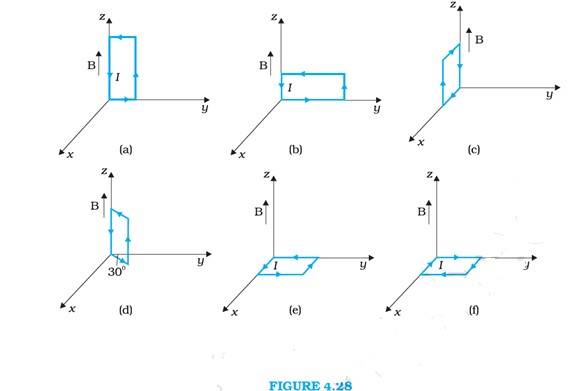4.24 A uniform magnetic field of 3000 G is established along the positive z-direction. A rectangular loop of sides 10 cm and 5 cm carries a current of 12 A. What is the torque on the loop in the different cases shown in Fig. 4.28? What is the force on each case? Which case corresponds to stable equilibrium?

4.24 A uniform magnetic field of 3000 G is established along the positive z-direction. A rectangular loop of sides 10 cm and 5 cm carries a current of 12 A. What is the torque on the loop in the different cases shown in Fig. 4.28? What is the force on each case? Which case corresponds to stable equilibrium?

-
1 Answer
-
4.24 Magnetic field strength, B = 3000G = 3000 T = 0.3 T
Length of the rectangular loop, l = 10 cm
Width of the rectangular loop, b = 5 cm
Area of the loop, A = l = 10 = 50 = 50
Current in the loop, I = 12 A
Assume that the anti-clockwise direction of the current is positive and vice versa.
Torque, =
From the given figure, it can be observed that A is normal to the y-z plane and B is directed along z-axis.
= 12*( 50 = Nm
The Torque is Nm along the negative y-direction.
The force on the loop is zero because the angle between A & B is zero.
This case is similar to case (a). The answer is same as case (a)
Torque, = I
F
...more
Similar Questions for you
There are two types of electricity - static and current. The current electricity is divided into Alternating Current (AC) and Direct Current (DC). Based on the production methods, electricity is divided into - heat, chemical, pressure, light and magnetism.
There are four types of power supply - switch-mode power supplies, linear power supplies, linear power supplies, and programmable power supplies
According to this law, at any point, magnetic field due to a tiny current element is directly proportional to the current element length.
Tesla (T) is the SI unit of magnetic field. Tesla is named after Nikola Tesla.
The different types of magnetism are - Diamagnetism, Paramagnetism, and Ferromagnetism.
Taking an Exam? Selecting a College?
Get authentic answers from experts, students and alumni that you won't find anywhere else
Sign Up on ShikshaOn Shiksha, get access to
- 65k Colleges
- 1.2k Exams
- 681k Reviews
- 1800k Answers
